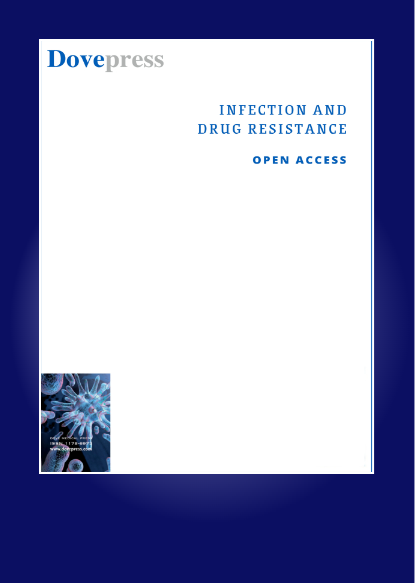营养指标可预测耐多药/利福平结核病患者的全因死亡率
IF 2.9
3区 医学
Q2 INFECTIOUS DISEASES
引用次数: 0
摘要
背景:耐多药和耐利福平肺结核(MDR/RR-TB)死亡率很高,仍然是一个公共卫生危机和健康安全威胁。本研究旨在探讨营养指标对 MDR/RR-TB 患者全因死亡率(ACM)的预测价值:我们回顾性地招募了 2015 年 1 月至 2021 年 12 月间的 MDR/RR-TB 患者,将他们随机分配到训练组和验证组。根据血红蛋白-白蛋白-淋巴细胞-血小板(HALP)评分、预后营养指数(PNI)和控制营养状况(CONUT)评分的接收者操作特征(ROC)分析得出的最佳临界值,将患者分为高营养风险组(HNRGs)和低营养风险组(LNRGs)。在训练队列中,采用卡普兰-梅耶生存曲线和对数秩检验来比较各组间的总生存率(OS)。Cox 风险比例回归分析用于探讨 MDR/RR-TB 患者 ACM 的风险因素。使用曲线下面积(AUC)、ROC分析的敏感性和特异性评估ACM的预测性能:共纳入 524 例 MDR/RR-TB 患者,其中 255 例为训练队列,269 例为验证队列。训练队列中的生存分析显示,HNRGs的OS明显低于LNRGs。调整协变量后,多变量分析发现,HALP 评分低、PNI 评分低和 CONUT 评分高是 MDR/RR-TB 患者发生 ACM 的独立风险因素。ROC 分析表明,HALP 评分、PNI、CONUT 评分及其组合的 AUC 分别为 0.765、0.783、0.807 和 0.811,对 ACM 具有良好的预测性能。在验证集中也观察到了类似的结果:结论:HALP 评分、PNI 和 CONUT 评分可有效预测 MDR/RR-TB 患者的 ACM。因此,在临床实践中应更加重视营养不良的常规筛查,以识别死亡风险较高的 MDR/RR-TB 患者,并为他们提供营养支持,从而降低死亡率。本文章由计算机程序翻译,如有差异,请以英文原文为准。
Nutritional Indices Predict All Cause Mortality in Patients with Multi-/Rifampicin-Drug Resistant Tuberculosis
Background: Multidrug- and rifampicin-resistant tuberculosis (MDR/RR-TB) with high mortality remains a public health crisis and health security threat. This study aimed to explore the predictive value of nutritional indices for all-cause mortality (ACM) in MDR/RR-TB patients.
Methods: We retrospectively recruited MDR/RR-TB patients between January 2015 and December 2021, randomly assigning them to training and validation cohorts. Patients were divided into high nutritional risk groups (HNRGs) and low nutritional risk groups (LNRGs) based on the optimal cut-off value obtained from receiver operating characteristic (ROC) analyses of the hemoglobin-albumin-lymphocyte-platelet (HALP) score, prognostic nutritional index (PNI), and controlling nutritional status (CONUT) score. In the training cohort, Kaplan-Meier survival curves and Log rank tests were used to compare overall survival (OS) between the groups. Cox risk proportion regression analyses were used to explore the risk factors of ACM in patients with MDR/RR-TB. The predictive performance of ACM was assessed using area under the curve (AUC), sensitivity and specificity of ROC analyses.
Results: A total of 524 MDR/RR-TB patients, with 255 in the training cohort and 269 in the validation cohort, were included. Survival analyses in the training cohort revealed significantly lower OS in the HNRGs compared to the LNRGs. After adjusting for covariates, multivariate analysis identified low HALP score, low PNI and high CONUT score were independent risk factors for ACM in MDR/RR-TB patients. ROC analyses demonstrated good predictive performance for ACM with AUCs of 0.765, 0.783, 0.807, and 0.811 for HALP score, PNI, CONUT score, and their combination, respectively. Similar results were observed in the validation set.
Conclusion: HALP score, PNI, and CONUT scores could effectively predict ACM in patients with MDR/RR-TB. Hence, routine screening for malnutrition should be given more attention in clinical practice to identify MDR/RR-TB patients at higher risk of mortality and provide them with nutritional support to reduce mortality.
Methods: We retrospectively recruited MDR/RR-TB patients between January 2015 and December 2021, randomly assigning them to training and validation cohorts. Patients were divided into high nutritional risk groups (HNRGs) and low nutritional risk groups (LNRGs) based on the optimal cut-off value obtained from receiver operating characteristic (ROC) analyses of the hemoglobin-albumin-lymphocyte-platelet (HALP) score, prognostic nutritional index (PNI), and controlling nutritional status (CONUT) score. In the training cohort, Kaplan-Meier survival curves and Log rank tests were used to compare overall survival (OS) between the groups. Cox risk proportion regression analyses were used to explore the risk factors of ACM in patients with MDR/RR-TB. The predictive performance of ACM was assessed using area under the curve (AUC), sensitivity and specificity of ROC analyses.
Results: A total of 524 MDR/RR-TB patients, with 255 in the training cohort and 269 in the validation cohort, were included. Survival analyses in the training cohort revealed significantly lower OS in the HNRGs compared to the LNRGs. After adjusting for covariates, multivariate analysis identified low HALP score, low PNI and high CONUT score were independent risk factors for ACM in MDR/RR-TB patients. ROC analyses demonstrated good predictive performance for ACM with AUCs of 0.765, 0.783, 0.807, and 0.811 for HALP score, PNI, CONUT score, and their combination, respectively. Similar results were observed in the validation set.
Conclusion: HALP score, PNI, and CONUT scores could effectively predict ACM in patients with MDR/RR-TB. Hence, routine screening for malnutrition should be given more attention in clinical practice to identify MDR/RR-TB patients at higher risk of mortality and provide them with nutritional support to reduce mortality.
求助全文
通过发布文献求助,成功后即可免费获取论文全文。
去求助
来源期刊

Infection and Drug Resistance
Medicine-Pharmacology (medical)
CiteScore
5.60
自引率
7.70%
发文量
826
审稿时长
16 weeks
期刊介绍:
About Journal
Editors
Peer Reviewers
Articles
Article Publishing Charges
Aims and Scope
Call For Papers
ISSN: 1178-6973
Editor-in-Chief: Professor Suresh Antony
An international, peer-reviewed, open access journal that focuses on the optimal treatment of infection (bacterial, fungal and viral) and the development and institution of preventative strategies to minimize the development and spread of resistance.
 求助内容:
求助内容: 应助结果提醒方式:
应助结果提醒方式:


